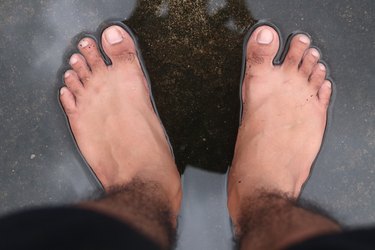
Standing on your tiptoes isn't just for ballerinas. The ability to flex your ankles and come onto the balls of your feet is fundamental for day-to-day activities (say, reaching for something on a shelf) as well as physical fitness (running, jumping, etc.).
And regularly raising on your tiptoes will strengthen your legs, calves and feet, says Jessica Mazzucco, certified posture specialist, lower-body fascial stretch therapist and founder of The Glute Recruit. "And for those with back pain, it could also help by putting the body into better alignment."
Video of the Day
Video of the Day
While hoisting your heels seems simple enough, it can be particularly challenging for some people to accomplish without toppling over or experiencing discomfort. Here are three reasons that could be restricting your relevé plus tips to help you lift onto your toes.
1. You Have Weak Calves
If you can't fully raise onto your toes, a weak calf muscle is often the most common cause, Mazzucco says. The gastrocnemius is a large muscle that comprises half of your calf (it runs down the back of your lower leg from behind your knee to your heel). And when it lacks strength, there can be a detrimental domino effect.
"A weak calf muscle can lead to problems such as stress and injury in the Achilles tendon and other areas such as the knees and plantar fascia [the band of tissue that stretches across the bottom of your foot and connects your heel bone to your toes]," Mazzucco says.
And all of these issues make it tougher to stand on your tiptoes. Plus, if you're a runner, weak calves can also diminish your "push off," leading to reduced speed and quicker fatigue, Mazzucco says.
Fix It
“Many of us have tight [or weak] calve muscles from sitting too much and a general lack of activity,” Mazzucco says. To counteract this, try movements that stretch and strengthen calves like calf raises.
- Stand on a step with your weight on the balls of your feet and your heels hanging off the step. Avoid placing all of your weight on the outside of your foot and make sure it's evenly distributed over your big toe. Use a banister for support if you need it.
- Raise up onto your toes and slowly lower your feet while your heels drop below the step level. That's one rep.
- Complete 2 to 3 sets of 10 lifts every other day.
As you grow stronger, you can hold weights in your hands to increase the challenge, Mazzucco says.
2. You Have Limited Ankle Mobility
Stiff ankles might be the source of your tiptoe woes. When you lack mobility in the ankle joint and flexibility in its surrounding tendons and muscles, you'll find it tougher to perform many exercises (think: squats).
Conversely, a flexible ankle will give you a wider range of motion in almost every movement you do, which includes standing on your tiptoes, Mazzucco says.
Fix It
Ankle mobility exercises can help stretch and strengthen your stiff ankles. Again, calf raises are a good place to start. You can also amplify your ankle flexibility and range of motion by doing this wall stretch:
- Stand facing a wall and place your front foot about a fist-size distance away.
- While bracing yourself against the wall, shift your body weight forward to allow your knee to get close to the wall and keep your heel touching the floor.
- As you get more range of motion, you can challenge yourself by stepping further back.
- Hold for 1 minute, then repeat on the opposite leg.
3. You Have a Fallen Arch or Flat Feet
If you have flat feet or fallen arches, standing on your toes will be a challenge. "Some people are born with flat feet, or it may occur over time when tendons in the lower leg weaken as a result of injury or wear," Mazzucco says.
In the latter case, when the posterior tibial tendon (a band of tissue that attaches the calf muscle to the bones on the inside of the foot) is injured or worn, it can no longer provide the same stability and support for the foot's arch, resulting in a fallen arch, per the Mayo Clinic.
Fix It
Practicing toe walking can strengthen the feet’s arches and help the body to better support your legs, resulting in less hip, ankle and back pain, Mazzucco says. She also recommends foot stretches like this one:
- While standing, press your right big toe into the floor and lift up your remaining toes. Hold for 5 seconds.
- Next, press your four toes into the floor while lifting up your big toe. Hold for 5 seconds.
- Repeat each way for 5 to 10 times, then switch and do the exercise on your left foot.
For a more advanced exercise, try heel raises: Place a tennis ball between your heels and squeeze them together as you lift your heels off the ground. This helps to strengthen your posterior tibialis tendon, which helps hold up the arch while walking.
If you’re dealing with discomfort due to fallen arches, consult a medical provider before you attempt any foot-related exercise, and stop any activity that causes or aggravates foot pain. Here are some other strategies for treating a fallen arch, according to the Mayo Clinic:
- If you experience pain, apply cold packs to the area 3 or 4 times a day for 20 minutes at a time.
- Take non-steroidal anti-inflammatory medications to alleviate arch pain and inflammation.
- Consider wearing a walking boot to stabilize the tendon or orthotics in your shoes to control the foot position.
- Opt for low-impact physical activities.